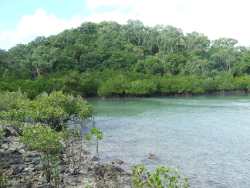|
|
Estuarine ecologyEsturarine wetlands are located in areas where a river, or other freshwater source, meets the sea. They provide an important habitat for a range of species. Many commercial species such as fish, crabs, prawns etc. start their life in estuarine areas. Mangroves are usually the most common vegetation as they are specially designed to deal with the high levels of salt found in the water and the often water-logged environment. These areas are also important when it comes to protecting the coastline from storm surges, cyclones etc.
Quick facts
Queensland Intertidal and Subtidal ecosystemsFor more information see Intertidal and Subtidal (Estuarine and Marine ecology) OzCoastsThe OzCoasts website provides conceptual diagrams depicting estuarine wetland processes, threats and stressors, including a range of geomorphic conceptual models for each of the seven types of Australian estuaries and coastal waterways. The descriptions supporting these diagrams also contain extensive amounts of useful information. Additional information
References
Last updated: 10 April 2017 This page should be cited as: Department of Environment, Science and Innovation, Queensland (2017) Estuarine ecology, WetlandInfo website, accessed 8 May 2025. Available at: https://wetlandinfo.des.qld.gov.au/wetlands/ecology/aquatic-ecosystems-natural/estuarine/ |

 — Department of the Environment, Tourism, Science and Innovation
— Department of the Environment, Tourism, Science and Innovation


